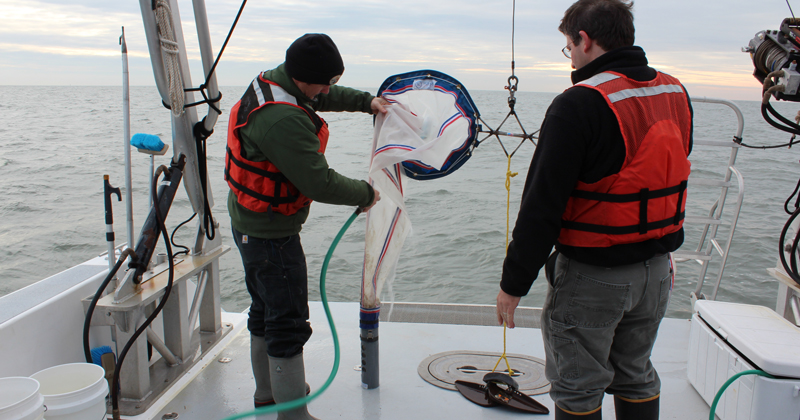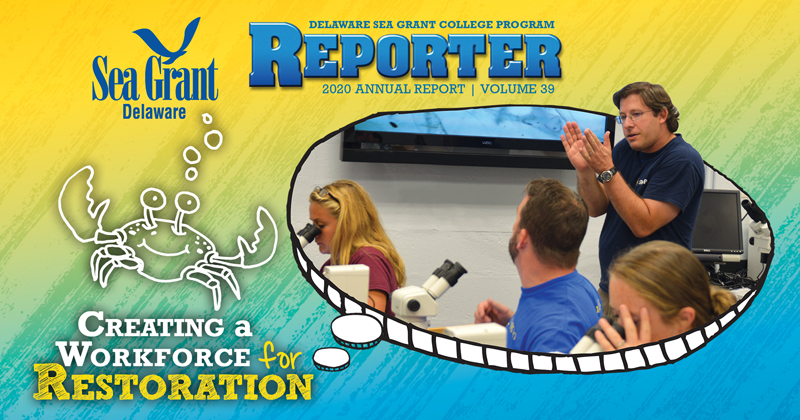


Understanding microplastics in the Delaware Bay
Photo by courtesy of Jonathan Cohen | Photo Illustration by Tammy Beeson July 20, 2020
Delaware Sea Grant project funds research of the emerging concern
Editors’ note: This story about research on microplastics at the University of Delaware’s College of Earth, Ocean and Environment is an excerpt from the annual report of Delaware Sea Grant (DESG), which funds much of the research. You can read more of the report on the DESG website, and you can register here to hear directly from researcher Jon Cohen during the Ocean Currents lecture on Thursday, July 23.
Scientists have realized in recent years that in addition to large garbage patches in the ocean, much smaller pieces of plastic — known as microplastics — also pose a serious problem for the world’s waterways. These microplastics, materials found in the marine environment that occur in sizes less than five millimeters, are broadly distributed as the most abundant form of marine debris observed at the ocean surface.
To help study microplastics in the Delaware Bay, Delaware Sea Grant (DESG) awarded funds in 2016 to Jonathan Cohen, associate professor in the School of Marine Science and Policy.
Cohen and Julie Steinberg, then a master’s student, used those initial funds to look at the distribution and concentration of microplastics in the Delaware Bay, collecting water samples at five stations and finding that microplastics were indeed present in the environment.
Steinberg helped analyze those samples and she, Cohen and UD undergraduate Haley Glos worked out methodologies to isolate the plastics from the rest of the samples to develop a standard protocol for sampling and identification of microplastics in water.
After that initial study, Cohen brought Anna Internicola, currently a Sea Grant-funded graduate student in Cohen’s lab, onboard to help continue the study. (As a joint Sea Grant-Delaware National Estuarine Research Reserve Fellow, Interrnicola undertook a smaller, related project this past year evaluating the St. Jones and Murderkill rivers.)
With the initial observations confirming that microplastics are a concern in Delaware Bay, the researchers wanted to dig deeper into how much can be found where and when, as well as what drives the microplastics distribution.
Tobias Kukulka, associate professor in CEOE, is the principal investigator on a closely related study to determine the distributions of microplastic marine debris, both by location and by time of year. The study is also examining physical controls and biological effects of the emerging pollution issue.
Together with Cohen and UD graduate student Alan Mason, Kukulka used physical oceanography and numerical modeling to determine that microplastics accumulate in the Delaware Bay in hot spots driven by buoyancy, winds and tides, all of which lead to high variability of microplastic distributions (across space and time) in the bay.
Specifically, these hot spots form at what are known as salinity fronts, areas where the fresh water from the Delaware River meets the salt water of the Atlantic Ocean.
Now, the researchers have received funds from DESG for 2020–2022 to try to understand the sources and the fate of microplastics, particularly as they are connected to land use.
Cohen and Kukulka will work with Helga Huntley, an associate research professor in CEOE, who is a physical oceanographer with expertise in ocean transport analysis, and Tracy DeLiberty, associate professor in CEOE and Graduate Geographic Information System (GIS) Certificate Director, to continue and expand the microplastics work.
The GIS will be used to understand the production of plastic and of mismanaged plastic waste along the Delaware Bay. They will use that information to pinpoint watersheds and sub-watersheds where they expect to find inputs of material in hopes of tying together the microplastic pathways from production to the biological impact.
“In these two years, we might not be able to solve the entire problem, but that’s the large picture and we’re going to try and start painting it,” said Huntley.
Ultimately, Cohen will look at how the microplastics are impacting creatures in and around the Delaware Bay. With information about the origins, transport and impact on biology, they can begin making specific management recommendations for particular regions and particular plastic groups.
“The ultimate goal is to make the link back to the biota,” said Cohen. “That’s the original question. Not just are plastics in the bay, but are they having a biological impact? That’s something that the state and other stakeholders are concerned about.”

Contact Us
Have a UDaily story idea?
Contact us at ocm@udel.edu
Members of the press
Contact us at 302-831-NEWS or visit the Media Relations website

